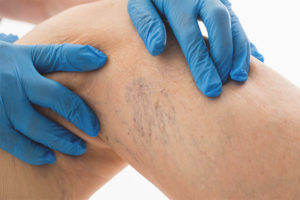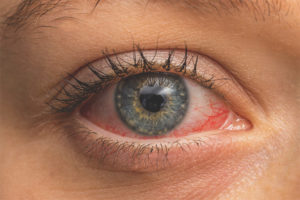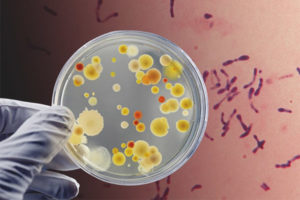The content of the article
Thrombophlebitis is an inflammation of the vein wall that leads to a thickening of the blood and the formation of a hard clot - a blood clot. As the thrombus grows, it can increase in size and closes the lumen of the venous outflow partially or completely. Thrombophlebitis is most often observed in acute or chronic form. Often the disease occurs against a background of varicose veins. Thrombophlebitis can be extremely dangerous, since a detached thrombus can block the flow of blood to vital organs. If a blood clot enters the pulmonary artery, acute disturbances occur in the respiratory system, and if a blood clot enters the heart valve, a stroke may develop. In this case, the patient’s life depends on the size of the detached blood clot, but more often, untimely recognition of symptoms and the lack of quick professional help leads to death.
Why does thrombophlebitis occur?
Most often, thrombophlebitis appears on the lower extremities, since it is the legs that experience maximum pressure and load. But why do some women boast beautiful, smooth and healthy legs until they are old, while others are already 30 years old and have serious vein problems? Here are a few reasons that provoke the development of thrombophlebitis.
- Increased coagulability. This is one of the most common causes of thrombophlebitis. Increased coagulability is a risk of blood clots. Hormonal malfunctions, abnormalities in the liver, as well as dehydration can lead to such a state of blood. That is, if you drink a little water, the blood thickens, which leads to the possible formation of clots.
- Inflammation. If the wall of the vein begins to become inflamed, blood may thicken in this place. Trauma of the lower extremities, autoimmune processes, any inflammatory or infectious processes in the body can lead to inflammation.
- Genes. Often, thrombophlebitis, as well as varicose veins, is a hereditary disease that occurs due to genetically weak vessels.
- Stagnation. Very often thrombophlebitis occurs due to venous stasis. This can occur in people whose profession is associated with standing on their feet. Hairdressers, sellers, cooks are forced to stand up all day, which leads to insufficient blood circulation in the lower extremities. The situation is aggravated if the patient has excess weight, which gives an additional load. Venous congestion also often occurs during pregnancy, as a result of rapid weight gain and a hormonal surge.
- External factors. Smoking, alcoholism, a sedentary lifestyle, an unhealthy diet are external causes that worsen the state of the blood vessels of the circulatory system. Therefore, they are also considered a provoking factor, which, coupled with the predisposition of the body, lead to thrombophlebitis.
Finding out the cause of the disease, you can deal with the problem much more effectively. But what are the symptoms of thrombophlebitis? How to detect the disease at an early stage?
How to recognize thrombophlebitis
Many patients are unaware of the disease at an early stage of its development, attributing the heaviness in the legs to normal fatigue after a hard day. This is fundamentally wrong, because early diagnosis and compliance with treatment measures will not allow the development of the disease. So what are the symptoms of thrombophlebitis?
- At the very beginning of the disease, the venous wall becomes inflamed, while without a blood clot.This leads to an uneven wall of the vessel, heaviness in the legs, swelling of the lower extremities, painful sensations after a hard day can appear. At such stages of the development of the disease, treatment is most effective.
- As thrombophlebitis progresses, the inflammation intensifies, the enlarged parts of the veins appear to the eye, the lumps become painful to the touch, and redness appears at the site of the inflamed vein. The pain can be either acute or pulling, and aching.
- Often at the site of an inflamed vein, local temperature rises, rarely a general increase in body temperature is observed.
- After a long walk and standing on legs, it is very difficult for a person to move, his legs hurt, the patient experiences acute discomfort.
- In addition, pain can be not only in the legs, but also in the lower abdomen, in the lower back and in the sacrum.
If such symptoms are found, it is very important to seek medical help, and not to "suppress" the pain with painkillers.
Medication for thrombophlebitis
Treatment of inflammation of the walls of blood vessels is prescribed only by a doctor, this is undeniable. However, we will present you the basic principles of the treatment of this unpleasant ailment.
- Anti-inflammatory drugs. Non-steroidal anti-inflammatory drugs can cope with the most important thing - inflammation of the vascular wall. Among them, Ibuprofen, Diclofenac, Nimesil can be noted.
- Anticoagulants. Anticoagulants are substances against high blood coagulation (Heparin, Enoxaparin, Clexane). They are taken to prevent the formation of new blood clots. Such drugs have a number of contraindications, since they can cause bleeding. Therefore, drugs should be prescribed after a thorough history and awareness of chronic diseases.
- Enzymes (phloenzyme, Wobenzym). They help relieve swelling, produce an anti-inflammatory effect, and most importantly, help existing blood clots resolve.
- Antibiotics. If thrombophlebitis has arisen against the background of trauma, surgery or has a post-injection nature, it is advisable to prescribe antibiotics.
- Thrombolytics. Thrombolytics are used to dissolve already formed blood clots and can only be used under the supervision of a doctor (in a hospital setting).
- Painkillers. They are needed in order to relieve a painful symptom and lower the temperature.
These are the main drugs that can be useful for thrombophlebitis. Only a doctor has the right to prescribe and adjust treatment due to the high risk of tearing off a blood clot.
Additional recommendations
In addition to the main drug treatment, the patient is prescribed to wear compression stockings and tights. By creating a certain pressure, medical underwear enhances the outflow of blood from the veins, which prevents its stagnation. Wearing such stockings should be all day, while the patient is in an upright position.
In the acute phase of thrombophlebitis, the patient is shown complete rest and bed rest. A pillow or something soft should be placed under the legs to improve the outflow of blood from the lower extremities. The patient is recommended to drink a lot of water to help thin the blood.
An external treatment for thrombophlebitis is necessarily prescribed. For this, various ointments and gels are prescribed that relieve inflammation, increase blood circulation, and dissolve blood clots. Among them are Heparin ointment, Troxevasin, Ketoprofen, Vishnevsky ointment.
Caution! In no case can you strongly rub the ointment into the veins, massage or rub them. Active physical exposure can lead to a blood clot rupture and death!
In the initial stages of thrombophlebitis, physiotherapeutic procedures, such as Dorsonval, may be helpful. Currents of low frequency stimulate nerve endings, increase blood circulation and promote resorption of blood clots.
At serious stages of the development of the disease, doctors can resort to surgical treatment of thrombophlebitis. With the formation of large blood clots, an operation is performed to pinpoint clots. With serious lesions of the veins, part of the diseased vein is removed.
Together with the main treatment for thrombophlebitis, it is very important to monitor the diet and follow a diet that will help you normalize your blood condition, reduce the amount of toxins and toxins, thereby reducing the risk of blood clots. You need to eat more fresh vegetables and fruits, lean meat, cereals. Avoid unhealthy and fatty foods. If there is excess weight - you need to get rid of it, because this is a huge load on the legs. With thrombophlebitis, therapeutic fasting is actively used for blood purification - for two days only liquid - juices, broth, tea, water.
Folk remedies against thrombophlebitis
The use of home recipes should only be as an additional treatment in parallel with conservative measures. Before using this or that advice, you need to consult a doctor about the possibility of its use in your particular case.
- Soda. Soda has a powerful anti-inflammatory and absorbable effect. You can make soda baths - dissolve a glass of powder in five liters of warm water and keep your feet in the liquid for at least half an hour. In addition, you can make soda-cabbage compresses. To do this, cabbage leaves need to be kneaded with a rolling pin on the board, mixed soda with vinegar. We apply soda gruel to inflamed veins, cover with cabbage leaf, wrap it with a film and warm it. The compress should be kept until the morning.
- Mummy. Altai mummy is an excellent tool for thinning and purifying blood, for strengthening immunity. 10 grams of the drug should be dissolved in two glasses of water and drink a black solution of two tablespoons in the morning on an empty stomach.
- Walnuts and olive oil. Green walnuts should be chopped and put in a glass bowl. Pour in warm olive oil. You need to insist the medicine for a month and a half, keeping it in a cool place and periodically shaking the composition. After the specified time, the composition should be filtered and lubricated with sore feet twice a day.
- Leaves of lilac. Lilac leaves have a good anti-inflammatory effect. They should be scrolled through a meat grinder, and the pulp should be applied to inflamed veins. Within half an hour you will notice significant relief.
- Leeches Leeches will help get rid of stagnation in the veins, improve blood circulation and draw out “bad” blood. They are applied to inflamed veins. This is one of the most popular folk remedies against thrombophlebitis.
- The roots of burdock. The roots of burdock should be cleaned, crushed and add oil. Boil this composition over low heat for about half an hour, after which it must be filtered and smeared inflamed veins with the prepared medicine.
Folk remedies are not a complete treatment, but they will help you relieve a pain symptom and accelerate recovery.
Thrombophlebitis is a common but very insidious disease. Hiding behind daily swelling, burning, and leg pain, it can develop rapidly and lead to dangerous and fatal consequences. Take care of your health, consult a doctor on time in order not to treat the disease, but in time to prevent its development.
Video: vein thrombosis of the lower extremities












Submit